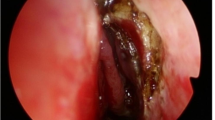Abstract
To study the outcome and complications of endoscopic endonasal dacryocystrhinostomy without stenting. Randomised prospective observational design. Tertiary academic centre. Seventy patients, clinically diagnosed as chronic dacryocystitis with nasolacrimal duct obstruction on the basis of syringing, were enrolled. Endoscopy was done for nasal pathology especially mucosal disease, hypertrophied turbinate, DNS. Seventy-eight eyes were operated with endoscopic-dacryocystorhinostomy along with additional surgeries and periodically followed up on OPD-basis at the end of 1st week, 2nd week, 1st month and 3rd month and evaluated clinically and by syringing (Ophthalmologist) and endoscopy done, wherever required. Insulated microear ball probe cautery was used to create nasal mucosal flap in all cases. Eleven patients underwent septal surgery along with one concha bullosa and one agger nasi removal (p < 0.05). Nil intraoperative complications (p < 0.05) and single postoperative complication noted (p < 0.05). Functional and anatomical patency found to be 100% at the end of 1st week, 98.7% at the end of 2nd week, 93.6% at end of 1st month and 91% at end of 3rd month. Nasal endoscopy showed restenosis in 1 patient at end of 2nd week, 4 patients at end of 1st month, 1 patient at the end of 3rd month along with granulation in 1 patient at the end of 3rd month. Revision surgery was done on 2 patients. Endoscopic dacryocystorhinostomy is safe and successful procedure for chronic dacryocystitis, due to nasolacrimal duct obstruction with less complications without stenting. The associated intranasal pathology, which might be the cause, can be corrected and bilateral dacryocystorhinostomy can be performed in single sitting reducing patient’s morbidity and hospital stay. Use of cautery with insulated ball probe for making nasal mucosal flaps gives an precise and excellent blood less field.













Similar content being viewed by others
References
Caldwell GW (1893) Two new operations for obstruction of the nasal duct with preservation of the canaliculi and an incidental description of a new lacrimal probe. NY Med J 57:581
Watkins LM, Janfaza P, Rubin PA (2003) The evolution of endonasal dacryocystorhinostomy. Surv Ophthalmol 48:73–84
Stammberger H (1986) Endoscopic endonasal surgery: concepts in treatment of recurring rhinosinusitis. Part 11. Surgical technique. Otolaryngol Head Neck Surg 94(2):147–156
Majidaee M, Mohammadi M, Rezaee MRS, Khademlu M, Gorji MAH (2014) Patients undergoing dacryocystorhinostomy surgery in northern Iran: an epidemiologic study. Ann Med Health Sci Res 4(3):365–368
Kennedy DW (1985) Functional endoscopic sinus surgery technique. Arch Otolaryngol Head Neck Surg 111(10):643–649
Korkut AY, Teker AM, Yazici MZ, Kahya V, Gedikli O et al (2010) Surgical outcomes of primary and revision endoscopic dacryocystorhinostomy. J Craniofac Surg 21:1706–1708
Leong SC, MacEwen CJ, White PS (2010) A systematic review of outcomes after dacryocystorhinostomy in adults. Am J Rhinol Allergy 24:81–90
Metson R (1991) Endoscopic surgery for lacrimal obstruction. Otolaryngol Head Neck Surg 104(4):473–479
Sprekelsen MB, Barberán MT (1996) Endoscopic dacryocystorhinostomy: surgical technique and results. Laryngoscope 106(2 Pt 1):187–189
Pittore B, Tan N et al (2010) Endoscopic transnasal dacryocystorhinostomy without stenting: results in 64 consecutive procedures. Acta Otorhinolaryngol Italica 30:294–298
Aslam MA et al (2014) Results of endoscopic endonasal dacrocystorhinostomy. JPMA 64:619
Mann BS, Wormald PJ (2006) Endoscopic assessment of the dacryocystorhinostomy ostium after endoscopic surgery. Laryngoscope 116:1172–1174
Mortimore S, Banhegy GY, Lancaster JL, Karkanevatos A (1999) Endoscopic dacryocystorhinostomy without silicone stenting. J R Coll Surg Edinb 44(6):371–373
McMasters M, Messerli J, Wolfensberger M (2000) Endonasal dacryocystorhinostomy: technique and results. Schweiz Med Wochenschr Suppl 116:74S–76S
Cokkeser Y, Evereklioglu C, Er H (2000) Comparative external versus endoscopic dacryocystorhinostomy: results in 115 patients (130 eyes). Otolaryngol Head Neck Surg. 123(4):488–491
Tsirbas A, Wormald PJ (2008) Mechanical endonasal dacryocystorhinostomy with mucosal flaps. Br J Ophthalmol. 87(1):43–47
Christensen L (1951) Localization of lacrimal sac in dacryocystorhinostomy by transillumination. AMA Arch Ophthalmol 46:501–503
Yigit O, Samancioglu M, Taskin U et al (2007) External and endoscopic dacryocystorhinostomy in chronic dacryocystitis: comparison of results. Eur Arch Otorhinolaryngol 264:879–885
Author information
Authors and Affiliations
Corresponding author
Ethics declarations
Conflict of interest
The authors declare that there are no conflict of interest.
Ethical Approval
Institutional ethical committee clearance was obtained before the study was started.
Informed Consent
Informed consent was obtained from all individual participants included in the study.
Rights and permissions
About this article
Cite this article
Yashveer, J.K., Chacko, A. Innovative Use of Insulated Microear Ball Probe Cautery in Creation of Nasal Mucosal Flap in EnDCR. Indian J Otolaryngol Head Neck Surg 70, 299–305 (2018). https://doi.org/10.1007/s12070-018-1274-y
Received:
Accepted:
Published:
Issue Date:
DOI: https://doi.org/10.1007/s12070-018-1274-y




